 Technology peripherals
Technology peripherals
 AI
AI
 Designing antibodies from scratch, Tencent and Peking University teams pre-trained large language models and published them in Nature sub-journal
Designing antibodies from scratch, Tencent and Peking University teams pre-trained large language models and published them in Nature sub-journal
Designing antibodies from scratch, Tencent and Peking University teams pre-trained large language models and published them in Nature sub-journal
 编辑 | KX
编辑 | KX
AI 技术在辅助抗体设计方面取得了巨大进步。然而,抗体设计仍然严重依赖于从血清中分离抗原特异性抗体,这是一个资源密集且耗时的过程。
为了解决这个问题,腾讯 AI Lab、北京大学深圳研究生院和西京消化病医院研究团队提出了一种预训练抗体生成大语言模型(PALM-H3),用于从头生成具有所需抗原结合特异性的人工抗体CDRH3,减少对天然抗体的依赖。
此外,还设计了一个高精度的抗原-抗体结合预测模型 A2binder,将抗原表位序列与抗体序列配对,从而预测结合特异性和亲和力。
总之,该研究建立了一个用于抗体生成和评估的人工智能框架,这有可能显着加速抗体药物的开发。
相关研究以「De novo generation of SARS-CoV-2 antibody CDRH3 with a pre-trained generative large language model」为题,于 8 月 10 日发布在《Nature Communications》上。
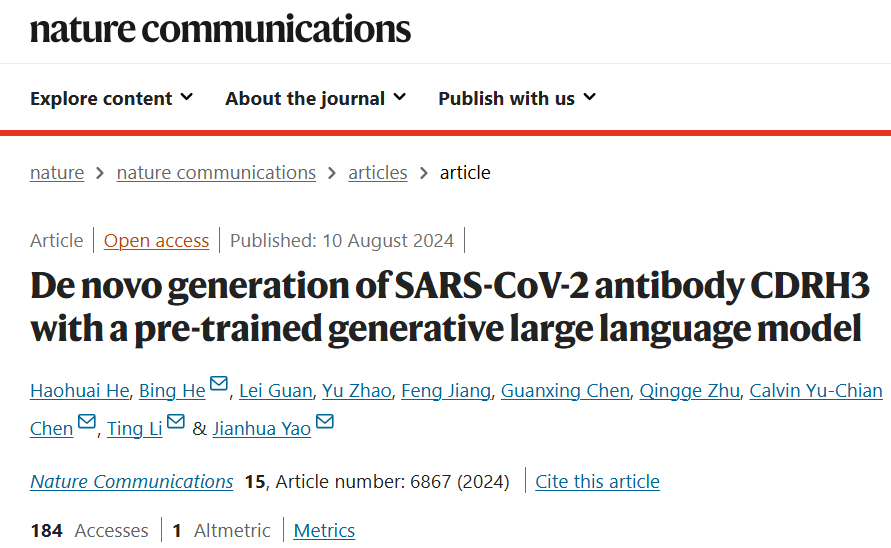
抗体药物,又称单克隆抗体,在生物治疗中发挥着至关重要的作用。通过模仿免疫系统的作用,这些药物可以选择性地针对病毒和癌细胞等致病因子。与传统治疗方法相比,抗体药物是一种更具体、更有效的方法。抗体药物在治疗多种疾病方面已显示出积极的效果。
开发抗体药物是一个复杂的过程,包括从动物源中分离抗体,使其人性化,并优化其亲和力。但抗体药物的开发仍然严重依赖于天然抗体。
蛋白质的序列数据可以看作是一种语言,因此自然语言处理(NLP)领域的大规模预训练模型已被用来学习蛋白质的表征模式。当前已经开发了多种蛋白质语言模型。然而,由于抗体的多样性高和可用的抗原抗体配对数据稀缺,生成对特定抗原表位具有高亲和力的抗体仍然是一项具有挑战性的任务。
为了应对上述挑战,腾讯AI Lab 团队提出了预训练抗体生成大型语言模型PALM-H3,用于优化和生成重链互补决定区3 (CDRH3),该区域在抗体的特异性和多样性中起着至关重要的作用。
为了评估 PALM-H3 产生的抗体对抗原的亲和力,研究人员结合使用了抗原抗体对接和基于 AI 的方法。
研究人员还开发了用于评估抗体-抗原亲和力的 A2binder。 A2binder 能够实现准确且可推广的亲和力预测,即使对于未知抗原也是如此。
PALM-H3 和 A2Binder 的框架
PALM-H3 和 A2binder 的工作流程和模型框架如下图所示。
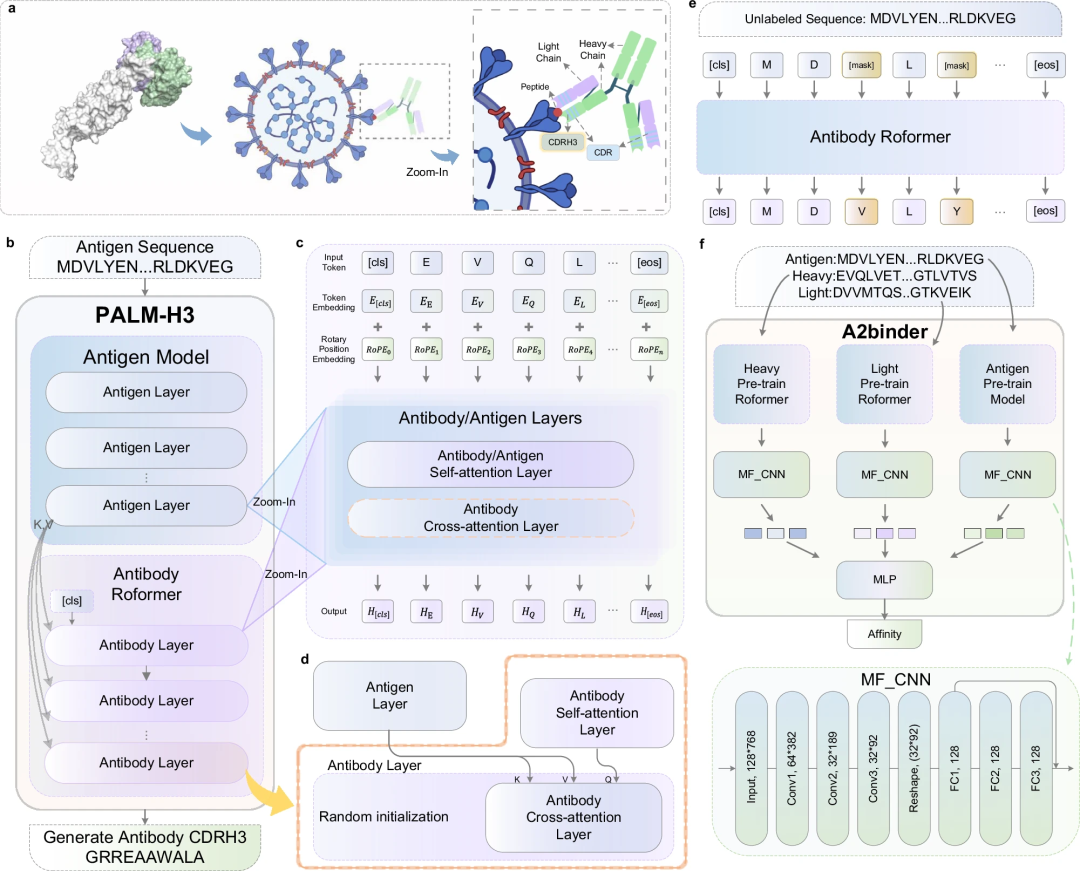
PALM-H3 的目的是生成抗体中的从头 CDRH3 序列。 CDRH3 区域在决定抗体对特定抗原序列的结合特异性方面起着最重要的作用。 PALM-H3 是一个类似 transformer 的模型,它使用基于 ESM2 的抗原模型作为编码器,使用抗体 Roformer 作为解码器。研究还构建了 A2binder 来预测人工生成的抗体的结合亲和力。
PALM-H3 和 A2binder 的构建包括三个步骤:首先,研究人员分别在未配对的抗体重链和轻链序列上预训练两个 Roformer 模型。然后,基于预训练的 ESM2、抗体重链 Roformer 和抗体轻链 Roformer 构建 A2binder,并使用配对亲和力数据对其进行训练。最后,使用预训练的 ESM2 和抗体重链 Roformer 构建 PALM-H3,并在配对抗原-CDRH3 数据上对其进行训练,以从头生成 CDRH3。
A2binder 可以准确预测抗原抗体结合概率、亲和力
通过将 A2binder 预测亲和力的能力与几种基线方法进行比较来评估其性能。
A2binder 在亲和力数据集上表现出色,部分原因在于抗体序列的预训练,这使得 A2binder 能够学习这些序列中存在的独特模式。
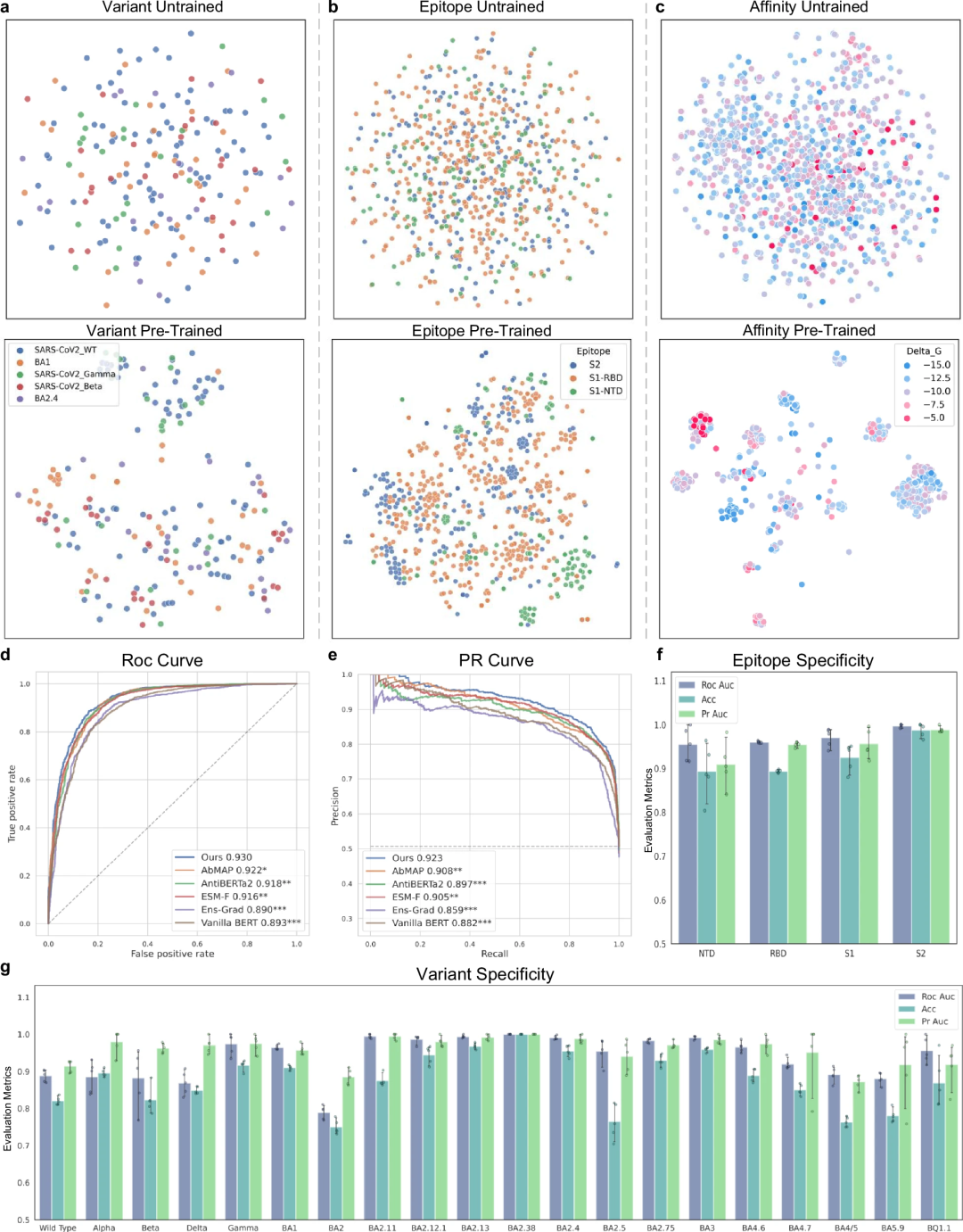
The results show that A2binder performs better than the baseline model ESM-F (the latter has the same framework, but the pre-trained model is replaced by ESM2) on all antigen-antibody affinity prediction datasets, which shows Pretraining with antibody sequences may be beneficial for related downstream tasks.
To evaluate the model’s performance in predicting affinity values, the researchers also utilized two datasets, 14H and 14L, that contain affinity value labels.

A2binder outperforms all baseline models on both Pearson correlation and Spearman correlation metrics. A2binder achieves a Pearson correlation of 0.642 on the 14H dataset (an improvement of 3%) and 0.683 on the 14L dataset (an improvement of 1%).
However, the performance of A2binder and other baseline models dropped slightly on the 14H and 14L datasets compared to other datasets. This observation is consistent with previous studies.
PALM-H3 excels in generating high-binding probability antibodies
Researchers explored the differences between the antibodies produced by PALM-H3 and natural antibodies. Their sequences were found to differ significantly, but the binding probabilities of the antibodies produced were not significantly affected by these differences. At the same time, their structural differences do lead to a decrease in binding affinity. These results are consistent with previous studies on network analysis of antibody libraries and generation of functional protein sequences.
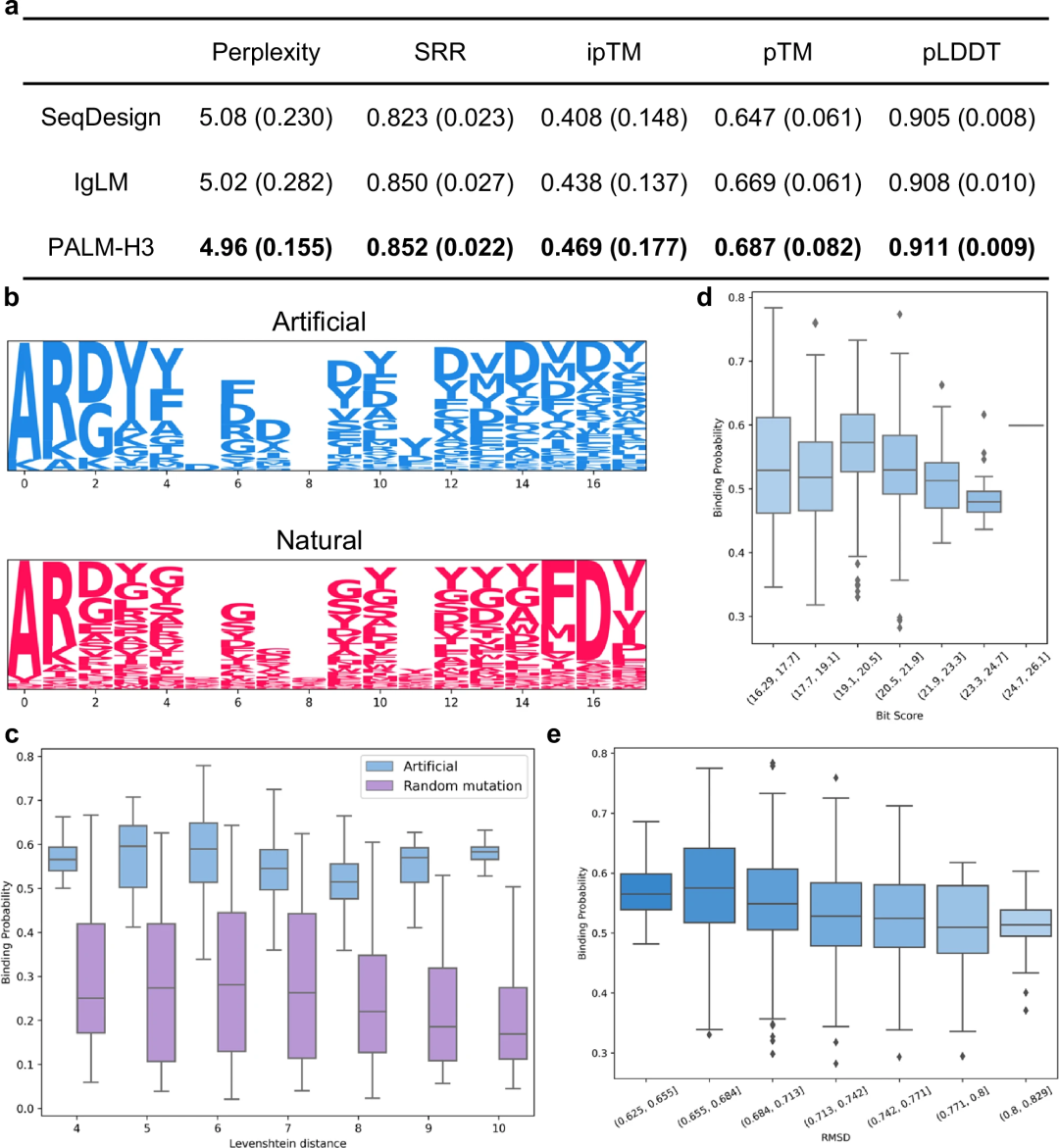
Overall, the results show that PALM-H3 is capable of generating a diverse range of antibody sequences with high binding affinities, although unlike natural antibodies.
In addition, researchers verified the performance of PALM-H3 through ClusPro and SnugDock. PALM-H3 is capable of generating antibodies against a stabilizing peptide in the HR2 region of SARS-CoV-2, the CDRH3 sequence. It generated a novel CDRH3 sequence and validated that the generated sequence GRREAAWALA has improved targeting of antigen-stabilizing peptides compared to the native CDHR3 sequence GKAAGTFDS.
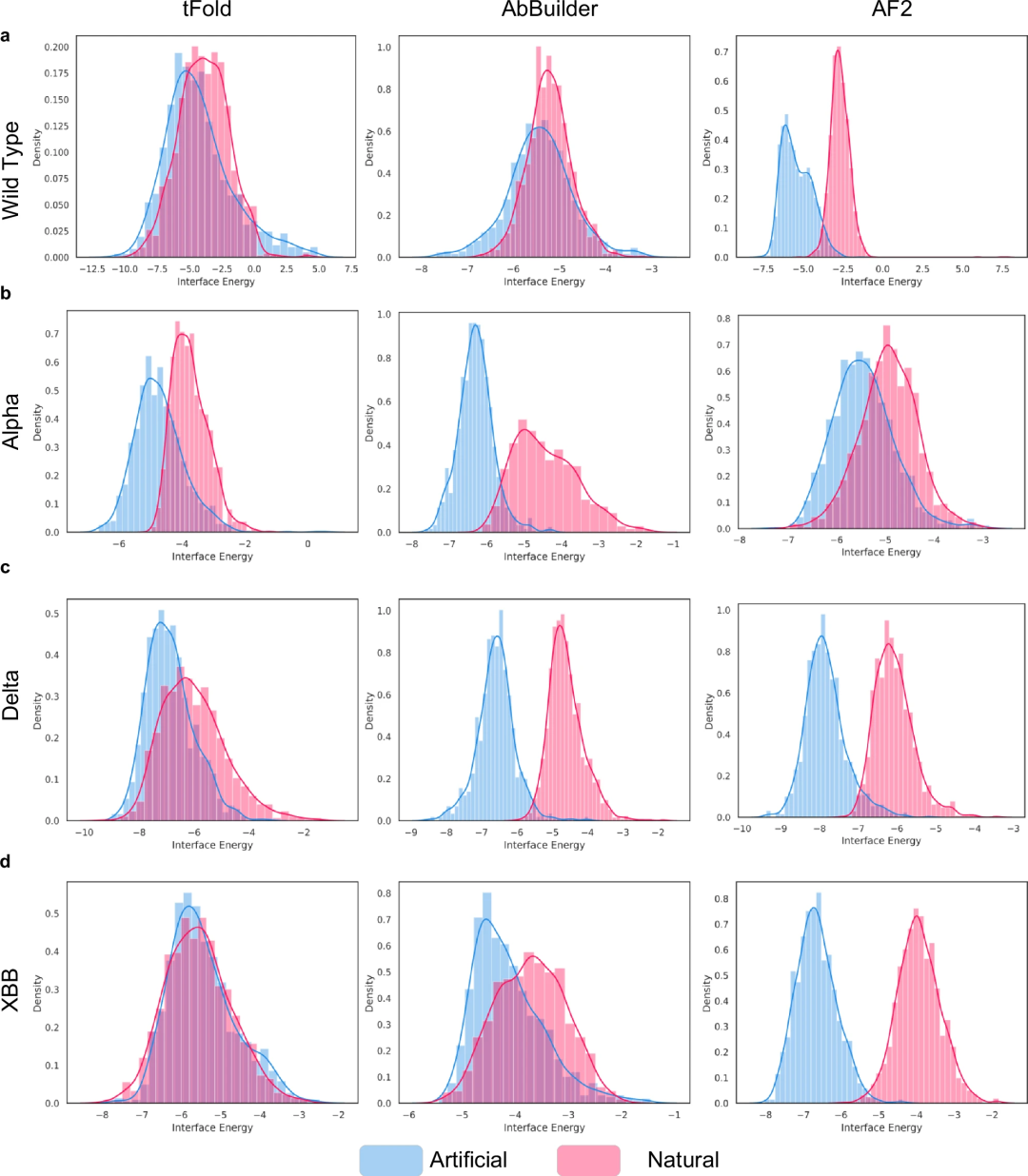
Additionally, PALM-H3 is able to generate antibodies with higher affinity against the emerging SARS-CoV-2 variant XBB CDRH3 sequence. The resulting sequence AKDSRTSPLRLDYS has a stronger affinity for XBB than its source, ASEVLDNLRDGYNF.
In addition, PALM-H3 not only overcomes the local optimal pitfalls faced by traditional sequential mutation strategies, but it also generates antibodies with higher antigen-binding affinity compared to the E-EVO approach. This highlights the advantages of PALM-H3 in antibody design, enabling more efficient exploration of sequence space and generation of high-affinity binders targeting specific epitopes.
In vitro experiments
In addition, the researchers also conducted in vitro experiments, including Western blotting, surface plasmon resonance analysis, and pseudovirus neutralization assays, providing key verification for the effectiveness of the PALM-H3 designed antibodies.

Two antibodies generated by PALM-H3 against SARS-CoV-2 wild-type, Alpha, Delta and XBB variant spike proteins achieved higher binding affinities than native antibodies in these experiments and neutralizing effect. The robust empirical results from these wet lab experiments complement computational predictions and analyses, validating the ability of PALM-H3 and A2binder to generate and select potent antibodies with high specificity and affinity for known and novel antigens.
In summary, the proposed PALM-H3 integrates the ability of large-scale antibody pre-training and the effectiveness of global feature fusion, resulting in excellent affinity prediction performance and the ability to design high-affinity antibodies. Furthermore, direct sequence generation and interpretable weight visualization make it an efficient and interpretable tool for designing high-affinity antibodies.
The above is the detailed content of Designing antibodies from scratch, Tencent and Peking University teams pre-trained large language models and published them in Nature sub-journal. For more information, please follow other related articles on the PHP Chinese website!

Hot AI Tools

Undresser.AI Undress
AI-powered app for creating realistic nude photos

AI Clothes Remover
Online AI tool for removing clothes from photos.

Undress AI Tool
Undress images for free

Clothoff.io
AI clothes remover

Video Face Swap
Swap faces in any video effortlessly with our completely free AI face swap tool!

Hot Article

Hot Tools

Notepad++7.3.1
Easy-to-use and free code editor

SublimeText3 Chinese version
Chinese version, very easy to use

Zend Studio 13.0.1
Powerful PHP integrated development environment

Dreamweaver CS6
Visual web development tools

SublimeText3 Mac version
God-level code editing software (SublimeText3)

Hot Topics
 1664
1664
 14
14
 1423
1423
 52
52
 1317
1317
 25
25
 1268
1268
 29
29
 1243
1243
 24
24
 Breaking through the boundaries of traditional defect detection, 'Defect Spectrum' achieves ultra-high-precision and rich semantic industrial defect detection for the first time.
Jul 26, 2024 pm 05:38 PM
Breaking through the boundaries of traditional defect detection, 'Defect Spectrum' achieves ultra-high-precision and rich semantic industrial defect detection for the first time.
Jul 26, 2024 pm 05:38 PM
In modern manufacturing, accurate defect detection is not only the key to ensuring product quality, but also the core of improving production efficiency. However, existing defect detection datasets often lack the accuracy and semantic richness required for practical applications, resulting in models unable to identify specific defect categories or locations. In order to solve this problem, a top research team composed of Hong Kong University of Science and Technology Guangzhou and Simou Technology innovatively developed the "DefectSpectrum" data set, which provides detailed and semantically rich large-scale annotation of industrial defects. As shown in Table 1, compared with other industrial data sets, the "DefectSpectrum" data set provides the most defect annotations (5438 defect samples) and the most detailed defect classification (125 defect categories
 Training with millions of crystal data to solve the crystallographic phase problem, the deep learning method PhAI is published in Science
Aug 08, 2024 pm 09:22 PM
Training with millions of crystal data to solve the crystallographic phase problem, the deep learning method PhAI is published in Science
Aug 08, 2024 pm 09:22 PM
Editor |KX To this day, the structural detail and precision determined by crystallography, from simple metals to large membrane proteins, are unmatched by any other method. However, the biggest challenge, the so-called phase problem, remains retrieving phase information from experimentally determined amplitudes. Researchers at the University of Copenhagen in Denmark have developed a deep learning method called PhAI to solve crystal phase problems. A deep learning neural network trained using millions of artificial crystal structures and their corresponding synthetic diffraction data can generate accurate electron density maps. The study shows that this deep learning-based ab initio structural solution method can solve the phase problem at a resolution of only 2 Angstroms, which is equivalent to only 10% to 20% of the data available at atomic resolution, while traditional ab initio Calculation
 NVIDIA dialogue model ChatQA has evolved to version 2.0, with the context length mentioned at 128K
Jul 26, 2024 am 08:40 AM
NVIDIA dialogue model ChatQA has evolved to version 2.0, with the context length mentioned at 128K
Jul 26, 2024 am 08:40 AM
The open LLM community is an era when a hundred flowers bloom and compete. You can see Llama-3-70B-Instruct, QWen2-72B-Instruct, Nemotron-4-340B-Instruct, Mixtral-8x22BInstruct-v0.1 and many other excellent performers. Model. However, compared with proprietary large models represented by GPT-4-Turbo, open models still have significant gaps in many fields. In addition to general models, some open models that specialize in key areas have been developed, such as DeepSeek-Coder-V2 for programming and mathematics, and InternVL for visual-language tasks.
 Google AI won the IMO Mathematical Olympiad silver medal, the mathematical reasoning model AlphaProof was launched, and reinforcement learning is so back
Jul 26, 2024 pm 02:40 PM
Google AI won the IMO Mathematical Olympiad silver medal, the mathematical reasoning model AlphaProof was launched, and reinforcement learning is so back
Jul 26, 2024 pm 02:40 PM
For AI, Mathematical Olympiad is no longer a problem. On Thursday, Google DeepMind's artificial intelligence completed a feat: using AI to solve the real question of this year's International Mathematical Olympiad IMO, and it was just one step away from winning the gold medal. The IMO competition that just ended last week had six questions involving algebra, combinatorics, geometry and number theory. The hybrid AI system proposed by Google got four questions right and scored 28 points, reaching the silver medal level. Earlier this month, UCLA tenured professor Terence Tao had just promoted the AI Mathematical Olympiad (AIMO Progress Award) with a million-dollar prize. Unexpectedly, the level of AI problem solving had improved to this level before July. Do the questions simultaneously on IMO. The most difficult thing to do correctly is IMO, which has the longest history, the largest scale, and the most negative
 PRO | Why are large models based on MoE more worthy of attention?
Aug 07, 2024 pm 07:08 PM
PRO | Why are large models based on MoE more worthy of attention?
Aug 07, 2024 pm 07:08 PM
In 2023, almost every field of AI is evolving at an unprecedented speed. At the same time, AI is constantly pushing the technological boundaries of key tracks such as embodied intelligence and autonomous driving. Under the multi-modal trend, will the situation of Transformer as the mainstream architecture of AI large models be shaken? Why has exploring large models based on MoE (Mixed of Experts) architecture become a new trend in the industry? Can Large Vision Models (LVM) become a new breakthrough in general vision? ...From the 2023 PRO member newsletter of this site released in the past six months, we have selected 10 special interpretations that provide in-depth analysis of technological trends and industrial changes in the above fields to help you achieve your goals in the new year. be prepared. This interpretation comes from Week50 2023
 To provide a new scientific and complex question answering benchmark and evaluation system for large models, UNSW, Argonne, University of Chicago and other institutions jointly launched the SciQAG framework
Jul 25, 2024 am 06:42 AM
To provide a new scientific and complex question answering benchmark and evaluation system for large models, UNSW, Argonne, University of Chicago and other institutions jointly launched the SciQAG framework
Jul 25, 2024 am 06:42 AM
Editor |ScienceAI Question Answering (QA) data set plays a vital role in promoting natural language processing (NLP) research. High-quality QA data sets can not only be used to fine-tune models, but also effectively evaluate the capabilities of large language models (LLM), especially the ability to understand and reason about scientific knowledge. Although there are currently many scientific QA data sets covering medicine, chemistry, biology and other fields, these data sets still have some shortcomings. First, the data form is relatively simple, most of which are multiple-choice questions. They are easy to evaluate, but limit the model's answer selection range and cannot fully test the model's ability to answer scientific questions. In contrast, open-ended Q&A
 The accuracy rate reaches 60.8%. Zhejiang University's chemical retrosynthesis prediction model based on Transformer was published in the Nature sub-journal
Aug 06, 2024 pm 07:34 PM
The accuracy rate reaches 60.8%. Zhejiang University's chemical retrosynthesis prediction model based on Transformer was published in the Nature sub-journal
Aug 06, 2024 pm 07:34 PM
Editor | KX Retrosynthesis is a critical task in drug discovery and organic synthesis, and AI is increasingly used to speed up the process. Existing AI methods have unsatisfactory performance and limited diversity. In practice, chemical reactions often cause local molecular changes, with considerable overlap between reactants and products. Inspired by this, Hou Tingjun's team at Zhejiang University proposed to redefine single-step retrosynthetic prediction as a molecular string editing task, iteratively refining the target molecular string to generate precursor compounds. And an editing-based retrosynthetic model EditRetro is proposed, which can achieve high-quality and diverse predictions. Extensive experiments show that the model achieves excellent performance on the standard benchmark data set USPTO-50 K, with a top-1 accuracy of 60.8%.
 Nature's point of view: The testing of artificial intelligence in medicine is in chaos. What should be done?
Aug 22, 2024 pm 04:37 PM
Nature's point of view: The testing of artificial intelligence in medicine is in chaos. What should be done?
Aug 22, 2024 pm 04:37 PM
Editor | ScienceAI Based on limited clinical data, hundreds of medical algorithms have been approved. Scientists are debating who should test the tools and how best to do so. Devin Singh witnessed a pediatric patient in the emergency room suffer cardiac arrest while waiting for treatment for a long time, which prompted him to explore the application of AI to shorten wait times. Using triage data from SickKids emergency rooms, Singh and colleagues built a series of AI models that provide potential diagnoses and recommend tests. One study showed that these models can speed up doctor visits by 22.3%, speeding up the processing of results by nearly 3 hours per patient requiring a medical test. However, the success of artificial intelligence algorithms in research only verifies this



